Lawn weeds identification is crucial to removing weeds and preventing their spread. If weeds are left unremoved, they can wreak havoc on your turf. They will suffocate your lawn by competing and stifling the nutrients from your turf.
Some of the most common are lawn weeds with yellow flowers. These are easy to spot because of the color of their flowers. But can you identify them?
Contents
Common Types of Yellow-flowered Weeds in Lawns
Common weeds with yellow flowers include:
- Dandelions
- Buttercup
- Black Medic
- Oxalis
- Black-eyed Susans
- Purslane
- Knotweed
- Creeping Cinquefoil
Dandelions
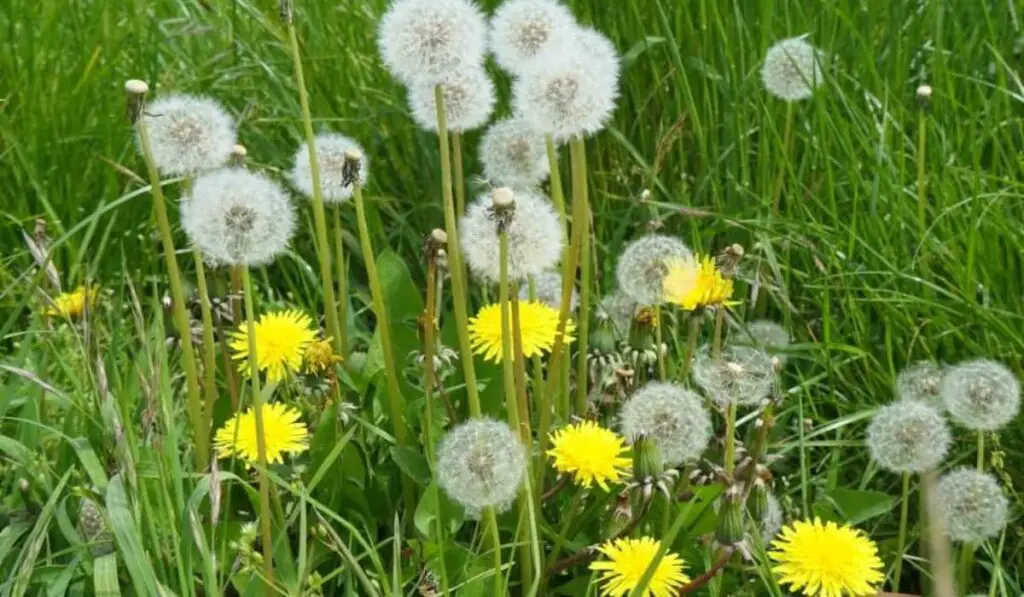
Dandelions are perennial broadleaf lawn weeds. They have yellow flowers that later become feathery seed heads. This weed has a deep root and dark green leaves, making them a pain to control when they spread onto your lawn.
Without digging out the weed’s root or killing it, the weed will again spread to other parts of your lawn.
Preventing and Eradicating Dandelions
Using a broadleaf herbicide is one of the most effective ways of killing dandelions. All one has to do is apply (spray) the herbicide on the weed plant leaves. This will kill the whole plant, including the root, without harming the lawn grass.
Other gardeners dig the dandelion to expose the root before applying the herbicide. However, it requires more work, especially if you have several dandelion plants invading your lawn.
Buttercup
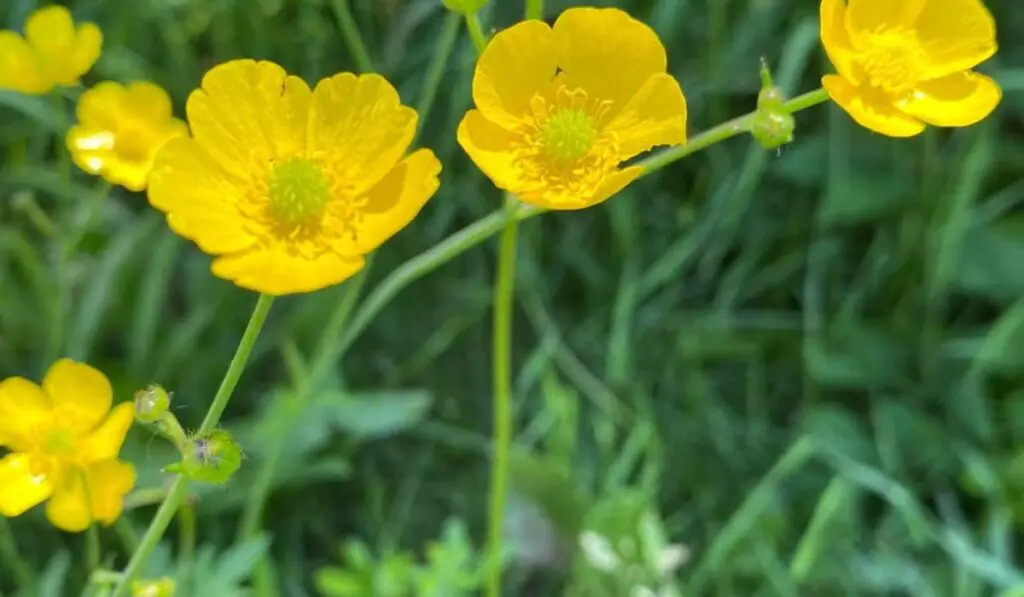
Also referred to as creeping buttercup, this weed has little yellow flowers that are pretty and cheerful. It is a perennial member of the ranunculus plant family and has creeping stems.
During late spring, buttercup will flower and later drop seeds leading to more weed plants on your lawn. Like most creeping weeds, the creeping buttercup can spread quickly on your lawn since it grows from rooted spots staked from the weed’s creeping stems or seeds.
Preventing and Eradicating Buttercup
The most effective way of controlling buttercup is by using pre-emergent herbicides. Pulling the buttercup weed from the ground is ineffective since it has widespread root systems. Even though the weed’s roots are shallow, they grow in a creeping pattern, making it problematic when pulling the entire root material from the ground.
The weed will re-emerge if any root material is left in the ground. Keep in mind that buttercup produces sap that can cause skin irritation. It’s advisable to wear gloves before pulling the weed.
Black Medic
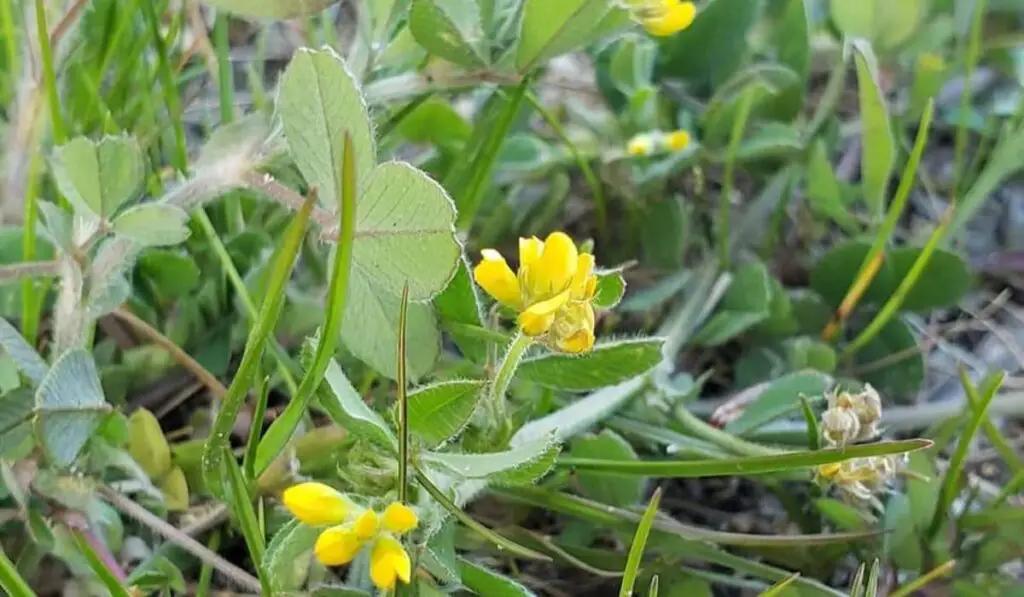
Black Medic is an annual weed with a similar appearance to white clover. The difference is that it has smaller, yellow flowers that bloom from the branching stems. This weed grows during the hot season of summer and yields seed pods that later drop after turning black and drying
Black Medic is not only one of the lawn weeds with yellow flowers but also an indication of the poor condition of your lawn soil. The weed mainly grows in compact soil that does not have adequate air.
Preventing and Eradicating Black Medic
Broadleaf herbicides are the most effective ways of eliminating the black medic weeds. Alternatively, use pre-emergent herbicides to control the weed.
Gardeners with only a few weed plants on their lawn may also prefer to pull them from the ground using their hands. Some gardeners get rid of black medic’s seed pods before they dry and drop. Such a strategy ensures the weed won’t grow back in the future.
Oxalis
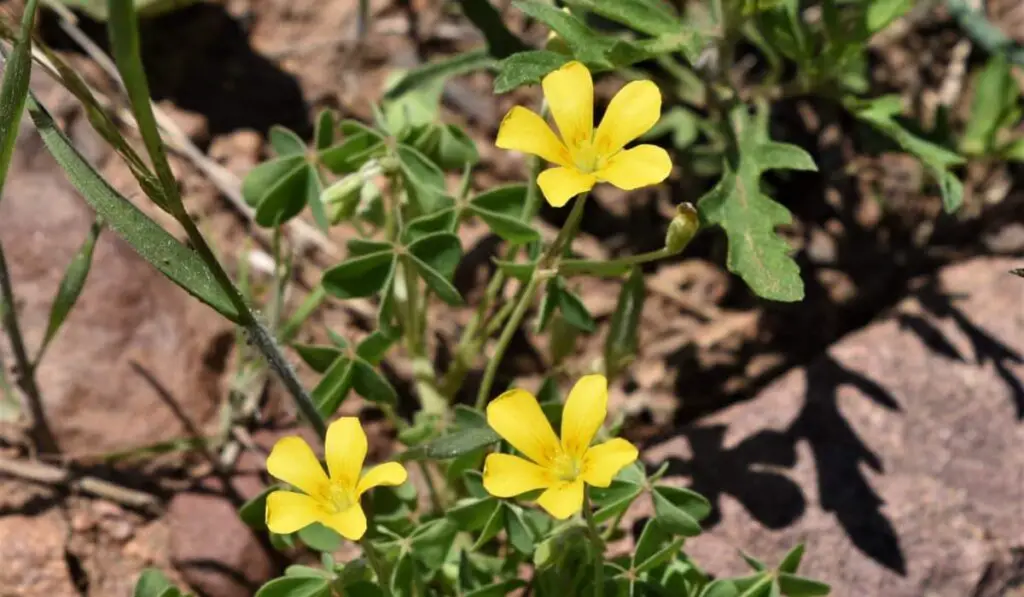
Oxalis, also called yellow wood sorrel, is a perennial weed with an upright stem that produces flowers with five petals.
In most cases, you will find a cluster of several oxalises growing together around a lawn spot. They form thick clusters that will compete for nutrients with your lawn grass. The weed only spreads through its seeds and can be persistent since it can grow in full shade or sunny conditions.
Preventing and Eradicating Oxalis
Perhaps the first measure of preventing the growth of oxalis and other lawn weed types is maintaining a healthy, thick, and well-kept lawn.
Non-selective herbicides can be effective in controlling oxalis. The herbicide must be applied before flowering and seed production. You may also use pre-emergent herbicides to prevent the growth of the weed.
Black-eyed Susans
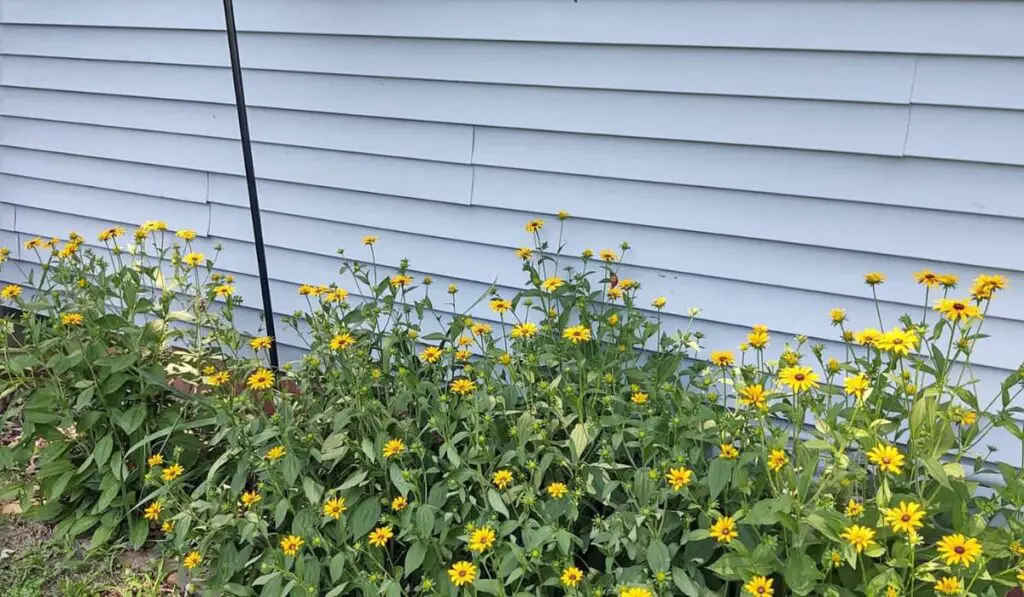
Black-eyed Susans are a wildflower that some people keep as a flowering plant. However, it grows unintended on lawns and becomes a weed.
Black-eyed Susans are persistent, drought resistant, and can grow even in hot and dry conditions during summer. The weed can stifle your turf and disperse hundreds of seeds if left unattended. Like most lawn weeds, it has a green stalk with leaves that have an alternating pattern. The stalks are thin and can grow to 2 feet in height.
The weed produces big yellow flowers with tiny brown flowers clustered in the middle. It is the clusters that later become seeds and disperse during the fall.
Preventing and Eradicating Black-eyed Susans
The simplest way of getting rid of Black-eyed Susans is to cut the flower head before it produces seeds. After this, you should pull the weed. Doing so will ensure the weed does not return when spring comes around.
Purslane
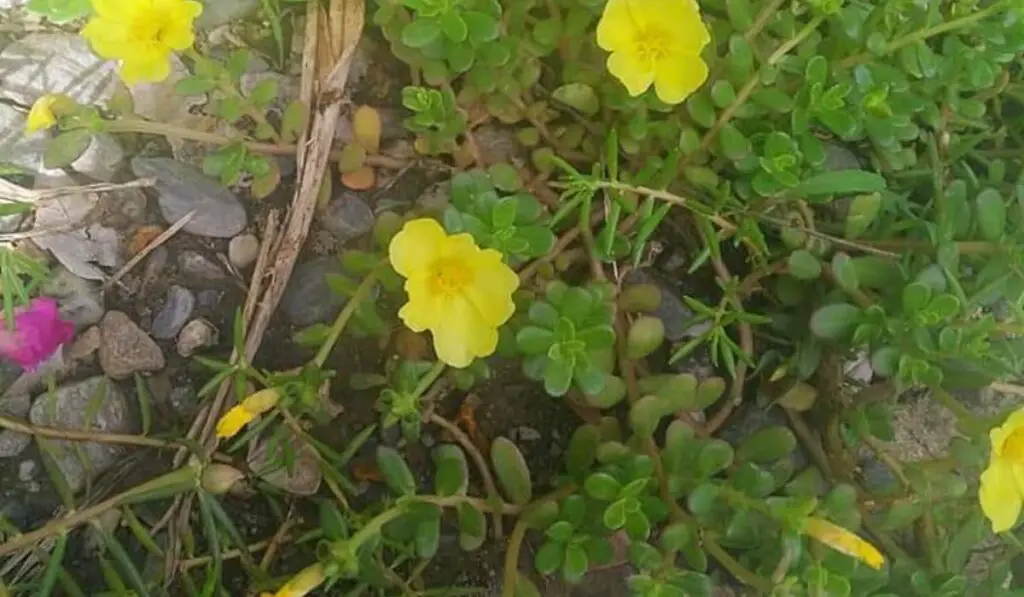
Purslane broadleaf weed has flowers with five petals and bright green leaves. It is one of the most persistent lawn weeds with yellow flowers because it spreads its seeds aggressively.
Purslane can regenerate itself from leftover bits of leaves or stems. New weeds can grow from the leftover stems in the following seasons.
Preventing and Eradicating Purslane
The most effective method of eradicating the Purslane weed is spraying it with a broadleaf herbicide. As an added measure, you may follow this by spraying a pre-emergent herbicide to thwart regrowth.
Pulling the weed is an option, but Purslane can regrow from leftover stems. When hand-pulling the weed, ensure you remove the entire center clump (basal rosette). After removing the weeds, please do not add them to the compost pile but put them in a paper bag so they do not drop any seeds.
Knotweed
Knotweed is another aggressive perennial weed that grows and forms thick mats. It has wiry stems that grow from a taproot. Even though it lives for a short period, it can be persistent and aggressive due to its rapid-spreading roots.
Knotweed produces yellow (or creamy white) flowers in clusters during late summer. The weed can be very destructive because of its fast-spreading nature, and the roots are strong enough to break through concrete foundations.
Preventing and Eradicating Knotweed
Having a well-maintained and healthy lawn that is fertilized and aerated can prevent the growth of knotweed on your turf.
It would be best to use granular chemical control and spot spray treatments for eradication. Repeat this treatment this for a few seasons to eradicate the weed.
Creeping Cinquefoil
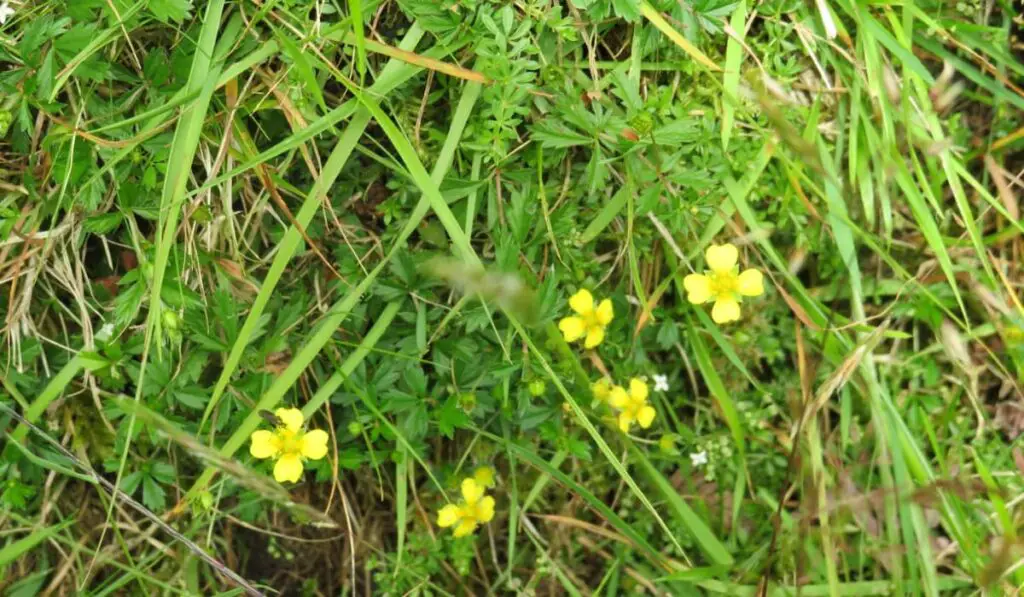
Creeping Cinquefoil is a common weed that invades poorly maintained lawns. It is easy to identify from its leaves with tooth-like edges with five separate segments. The flowers of the weed are fleshy and yellow.
Creeping Cinquefoil can be aggressive by spreading using its runners that form roots at intervals to form new plants. The weed is also notorious for making your lawn look uneven in appearance.
Preventing and Eradicating Creeping Cinquefoil
Some gardeners use their hands to pull the weed plants. However, this mode of eradication is not very effective. The best method is by spraying a selective herbicide. It would be best if you sprayed again six weeks after the first treatment to eliminate the weed.
Keeping a healthy and well-maintained lawn can also be very effective in discouraging the invasion of the weed onto your lawn. Scarifying and raking can also help weaken the weed and eradicate it.
FAQs
What are the small yellow flowers growing on my lawn?
The small yellow flowers growing on your lawn are weeds, probably Purslane.
How do I get rid of oxalis on my lawn?
The most effective way of getting rid of oxalis is by spraying a herbicide on the weed. After this, you should follow up the treat by spraying a pre-emergent herbicide to prevent weed regrowth in future seasons.
How do I get rid of creeping buttercup?
The most effective way of getting rid of creeping buttercup is to spray a herbicide and follow it up with a pre-emergent herbicide. Doing so will prevent the creeping buttercup weed from regrowing on your lawn in future seasons.
Hello! My name is Chris, and I am the founder of Yard Floor. When I was a toddler, my family had a lush green lawn. I was at the center of caring for and maintaining this lawn and even proceeded to take an associate’s Degree in landscaping. I am here to share my years of experience with you – be it repairing your mower/tractor or caring for your lawn.